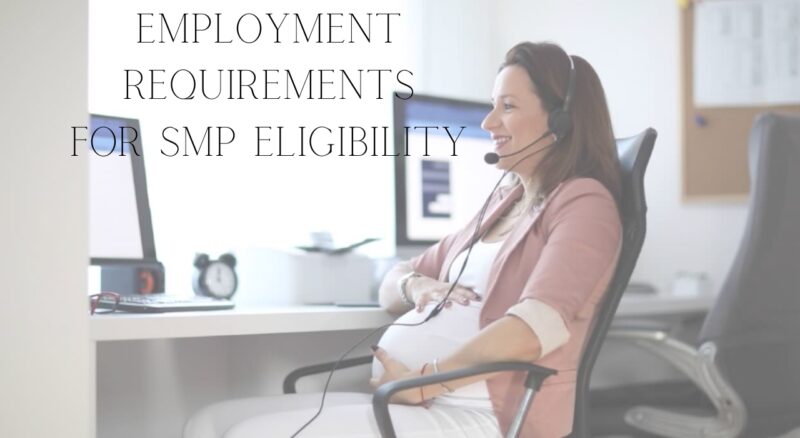As I sat in the doctor’s office, the two pink lines on the pregnancy test confirming the exciting news, a flurry of thoughts raced through my mind. Amid the joy and anticipation, there was one question that loomed large: how would I manage my career while ensuring the best for my baby?
That’s when I first came across the term SMP – Statutory Maternity Pay. It was a phrase that would become a lifeline, a beacon of support during the thrilling, yet challenging journey of motherhood.
What is it?
Statutory Maternity Pay (SMP) is a legal entitlement in the United Kingdom that provides financial support to eligible working mothers during their maternity leave. It is a weekly payment made by employers to eligible employees who are on maternity leave.
This entitlement is a part of the UK’s employment benefits system, designed to help women maintain a level of income during a period when they are unable to work due to pregnancy and childbirth.
The purpose of SMP is to provide financial support to women during their maternity leave, allowing them to take necessary time off work to care for their newborn and recover from childbirth. This support is crucial in ensuring that women do not face financial hardship due to their decision to start a family.
The whole concept is rooted in the understanding that the period of maternity is a crucial time for both the mother and the newborn, and financial stability during this time can significantly impact the well-being of both.
Its Importance for Working Mothers
The importance of SMP for working mothers is multifaceted. On a fundamental level, it provides a safety net for working mothers, ensuring they can focus on their health and the well-being of their newborn without the added stress of financial instability.
This financial support allows women to take the necessary time off work for their maternity leave without the fear of losing their income entirely. On a broader level, SMP contributes to gender equality in the workplace by ensuring that women do not have to choose between their career and motherhood.
Legal Context and Eligibility Criteria

SMP is enshrined in the UK’s employment law framework. It is a statutory right, meaning it is protected by law and must be provided by employers who meet certain criteria. The eligibility for SMP is determined by several factors, including the length of employment, earnings, and the timing of the leave.
Understanding these criteria is essential for working women to ensure they receive the benefits they are entitled to.
Qualifying Conditions
To qualify for SMP, a woman must meet several conditions. She must have been employed by the same employer continuously for at least 26 weeks up to the ‘qualifying week’ – the 15th week before the expected week of childbirth. She must also earn at least the lower earnings limit (LEL) for National Insurance contributions.
These conditions ensure that SMP is provided to those who have a substantial employment history with their employer.
Employment Requirements for SMP Eligibility

Beyond the length of employment and earnings, a woman must also provide the correct notice and proof of pregnancy to her employer. She must notify her employer at least 28 days in advance (if possible) of the date she intends to stop work to start her maternity leave.
Additionally, she must provide a medical certificate (MAT B1 form) confirming her expected week of childbirth. These requirements ensure that employers have sufficient notice to plan for the employee’s absence and to arrange for the payment of SMP.
Role of the Government
The role of the government in providing SMP is primarily regulatory. The government sets the legislation that outlines the eligibility criteria, payment rates, and duration of SMP. This legislation ensures that all eligible women, regardless of their employer, receive the same minimum level of support.
The government also provides guidance to employers on how to calculate and administer SMP, ensuring that it is implemented correctly and fairly across all workplaces.
Maternity Leave
Maternity leave is a period of time when a woman takes off from work because she is about to have, or has just had, a baby. This leave is not just about recovery from childbirth; it’s also a crucial time for mothers to bond with their newborn, establish a routine, and adjust to their new role as a parent.
The provision of SMP during this period ensures that women can afford to take this time off work.
Calculating Statutory Maternity Pay
The calculation of SMP is based on a woman’s average weekly earnings in the ‘relevant period’, usually the eight weeks or two months up to and including the last payday before the end of the qualifying week.
The rate of SMP is currently 90% of the woman’s average weekly earnings for the first six weeks, followed by a flat rate for the remaining weeks. This calculation ensures that the amount of SMP a woman receives is reflective of her regular income, providing a fair level of support.
How long does it last?

SMP is paid for up to 39 weeks. The first six weeks are paid at 90% of the woman’s average weekly earnings, with no upper limit. The remaining 33 weeks are paid at the SMP standard rate or 90% of the woman’s average weekly earnings, whichever is lower. This duration ensures that women receive financial support throughout the majority of their maternity leave.
Possibility of Combining SMP with Other Benefits
It’s possible to combine SMP with certain other benefits, such as Maternity Allowance for women who don’t qualify for SMP, or Child Tax Credit. However, the rules around this can be complex, and it’s recommended to seek advice from an expert or use an online benefits calculator to understand what you might be entitled to.
This combination of benefits can provide additional support to women during their maternity leave.
Notifying the Employer
When it comes to notifying the employer about pregnancy and intention to take maternity leave, timing and documentation are key. This should be done at least 15 weeks before the baby is due, and the woman should provide a MAT B1 form, which is a medical certificate that confirms the expected week of childbirth.
This notice allows the employer to make necessary arrangements for the woman’s absence and to prepare for the payment of SMP.
Differences between SMP and Maternity Allowance
While SMP and Maternity Allowance both provide financial support during maternity leave, they differ in several ways. SMP is paid by employers to eligible employees, while Maternity Allowance is a benefit paid by the government to women who do not qualify for SMP.
This could be because they’re self-employed, or because they haven’t been employed for long enough by the same employer.
Determining the Appropriate Benefit
The appropriate benefit will depend on a woman’s individual circumstances, including her employment status, earnings, and length of employment. It’s important to understand the eligibility criteria for both SMP and Maternity Allowance to ensure that you claim the right benefit.
How Company Policies May Supplement SMP?
Some companies offer enhanced maternity pay schemes that are more generous than the statutory provisions. These can include higher payment rates, longer payment durations, or additional benefits such as paid time off for antenatal appointments.
These enhanced schemes can provide significant additional support to working mothers, helping them to manage the financial impact of maternity leave more effectively.
Additional Benefits or Support
In addition to enhanced maternity pay, some employers may offer additional support such as flexible working arrangements, childcare vouchers, or employee assistance programs. These can provide valuable support to working mothers, helping them balance their work and family commitments.
This additional support can make a significant difference in the experience of working mothers, helping them to maintain a better work-life balance during this challenging period.
Returning to Work
Upon returning to work after maternity leave, women have certain rights and protections. They have the right to return to the same job if the leave was 26 weeks or less, or to a suitable and appropriate job if the leave was more than 26 weeks.
They are also protected against unfair treatment or discrimination because of their maternity leave. These protections are crucial in ensuring that women do not face negative consequences in their career due to their decision to have a child.
Flexible Working Arrangements and Parental Leave Options
Flexible working arrangements can include part-time work, flexitime, job sharing, or working from home. These arrangements can help women to balance their work commitments with their new responsibilities as a parent. Additionally, parental leave is a separate entitlement that allows parents to take time off work to look after a child’s welfare.
This can provide additional flexibility for parents in managing their work and family commitments.
Paternity Pay Entitlements
Statutory Paternity Pay (SPP) is a legal entitlement for eligible fathers to take time off work to care for their newborn or adopted child. It is paid at the same rate as SMP and can be taken for one or two weeks.
This entitlement recognizes the important role of fathers in the early stages of a child’s life and ensures that they have the opportunity to take time off work to care for their child.
Shared Parental Leave Options
Shared Parental Leave (SPL) is a relatively new entitlement that allows eligible parents to share up to 50 weeks of leave and up to 37 weeks of pay. It provides greater flexibility in how parents can share the care of their child in the first year following birth or adoption.
This flexibility can help parents to balance their work and family commitments more effectively, ensuring that both parents have the opportunity to spend time with their child during this important period.
Self-Employed Women

Unfortunately, self-employed women do not qualify for SMP as it is paid by employers. However, they may be eligible for Maternity Allowance, which is a weekly payment made by the government. This allowance provides an important source of financial support for self-employed women during their maternity leave.
Maternity Allowance for Self-Employed Individuals
Maternity Allowance is paid for up to 39 weeks. The rate depends on a woman’s eligibility but can be up to the same rate as SMP. It is an important benefit that provides financial support to self-employed women during their maternity leave.
This support can help self-employed women to maintain their business during their maternity leave, ensuring that they do not face financial hardship due to their decision to have a child.
FAQs:
Can an employer refuse to pay?
Employers must have valid reasons and follow legal procedures to refuse SMP.
Can an employee claim SMP if they are adopting a child?
Yes, eligible adoptive parents can claim Statutory Adoption Pay, which is similar to SMP.
Is it affected by bank holidays or public holidays?
SMP is not affected by bank holidays or public holidays and continues as usual during these times.
What happens if an employee is made redundant?
Redundancy rights and entitlements apply to employees on SMP, and they have priority over other employees in certain cases.
Is it possible for an employee to change their return-to-work date after SMP begins?
Yes, an employee can change their return-to-work date by giving proper notice to the employer.
Understanding the crucial timing for sharing the wonderful news of your pregnancy at work can significantly impact your eligibility for SMP (Statutory Maternity Pay).”
Conclusion
SMP plays a crucial role in supporting working mothers during their maternity leave. It provides a safety net that allows women to take necessary time off work to care for their newborn and recover from childbirth without the fear of financial instability.
This support is crucial in ensuring that women do not face financial hardship due to their decision to start a family. The government’s efforts to provide financial assistance and job protection to new mothers through SMP and other benefits are commendable.
These measures help to promote gender equality in the workplace and support the health and well-being of mothers and their newborns.
By providing financial support during maternity leave, SMP plays a crucial role in supporting the health and well-being of mothers and their newborns, promoting gender equality in the workplace, and contributing to a more inclusive and supportive society.

